Recent Articles
Strange banana ripening
9.9 years ago banana, ripe Leave a comment
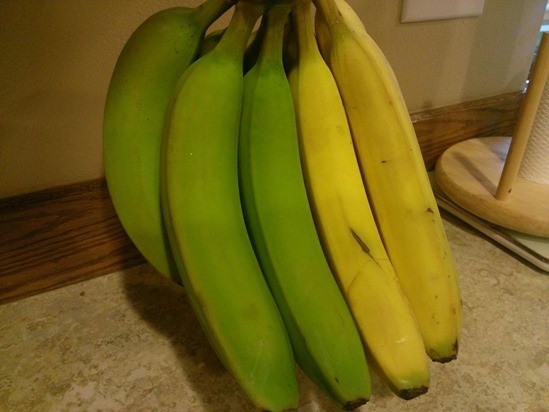
This is definitely a first for me, sort of a happy accident so the bananas do not ripen all at once and end up with a bunch of overripe ones before you can eat them…if only I could determine how to make this happen on purpose I could make millions 🙂
Ultimate Plant Cage/Stake/Plant clip review
10 years ago planter, product review, trellis 1 Comment
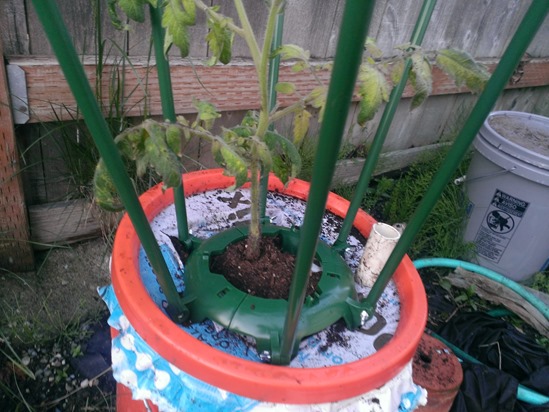
This nice people at Global Garden Friends were nice enough to send me a few of their product to try out with my garden this year and given today I was bringing out my cucumbers, tomatoes, zucchini, and pumpkins from the grow box it seemed like a great time to put them to the test.
The first product I tried out was their Ultimate Plant Cage which is a plastic ring that comes in four parts with spikes you can stab into the soil. I used this on my self watering planter which I just planted a tomato plant into today.
What I like about this system is you can actually assemble this around your plant which is helpful if you are a bit late adding a plant cage to your plants. Also on this right are six small posts which you can attach their Ultimate Plant Stakes (included with the kit) where you can adjust the height and the width as needed to support your growing plant.
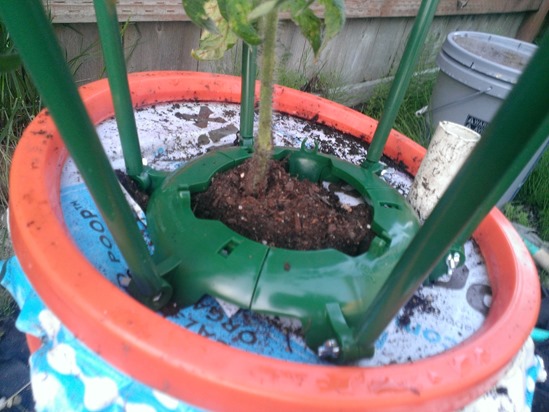
I also use a few more of their Ultimate Plant Stakes to give my peas a little help as they start to take off in the next couple weeks. The only complaint I have for these is there is not a lot of resistance when you extend these stakes so supporting from an angle may work ok but if your weight is a direct downward force I could see these potentially collapsing under some load.
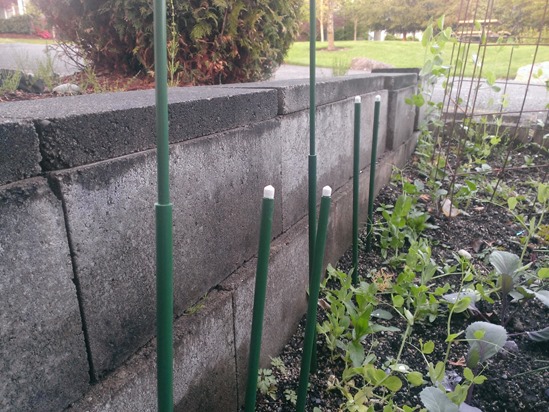
In addition they also sent me some plant clips which you can use to assist your vegetables to climb their trellis until they have adequate support on their own. I have done twine and zip ties in the past but what I like about these is they are much easier to remove when the time comes and also pretty large so easy to find to reuse on other plants as needed.

I suspect I will be able to use them to help my peas, tomatoes, and cucumbers find their trellises when the time comes.
Cheap desktop aquaponics system
10 years ago Uncategorized 3 Comments
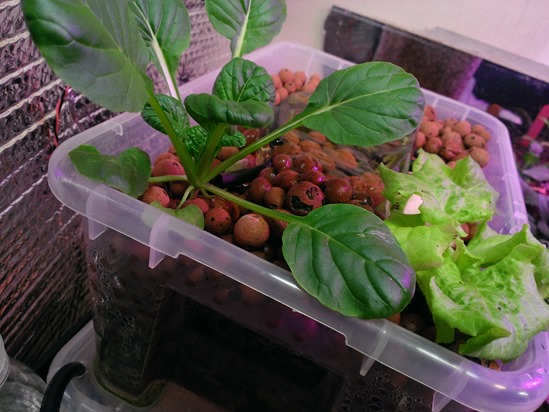
I wanted to create a fun project with my daughter and a proof of concept for an aquaponics setup to have running in my grow box. For those of you new to this concept this is growing plants in a soilless environment (much like hydroponics) but instead of paying for expensive nutrients you use naturally occurring bacteria and fish poop to grow plants.
Now there are fish farm kits out there but given most of the parts for this build I had sitting idle in my garage I decided to construct my own.
First after a trip to IKEA I found some plastic tubs just the right size for my grow box. I got two of the bins and one lid.
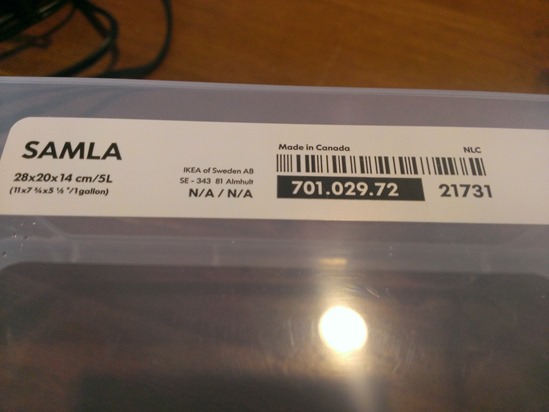
This is the basic idea of how this goes together, fish in the bottom plants on top.
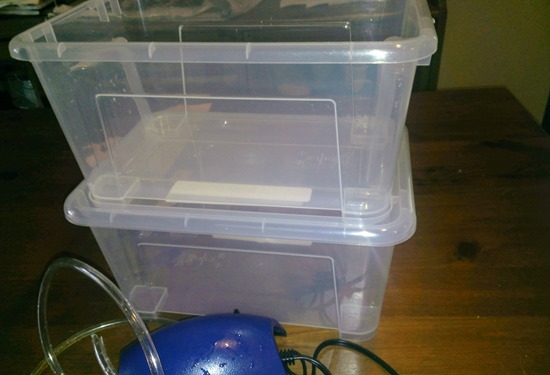
Next I took a 1/4 inch drill and made several holes on both the bottom of the top tub and also through the lid. I also added a few extra hole in the lid to ensure water can drain faster from the lid than the water coming in from above. I also drilled a big enough to fit some 1/2 in plastic tubing from an old fountain pump I had lying around.
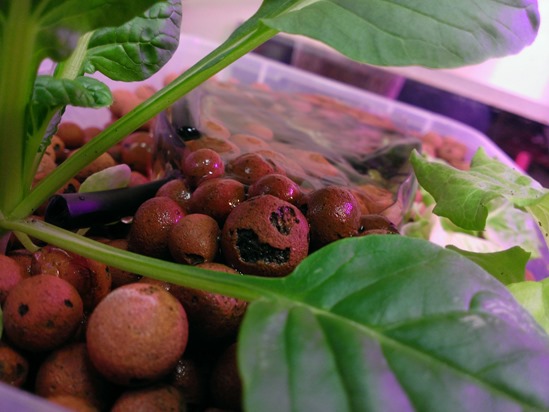
It is a bit hard to see from this picture but I cut the top of a 2 liter bottle off and drilled a hole in the cap just big enough to fit the top of the plastic tubing through. I then drilled six 1/4 holes and pushed a 6 small pieces of irragaction tubing (pieces of straws could probably work here as well) and positioned them right under the plants roots.
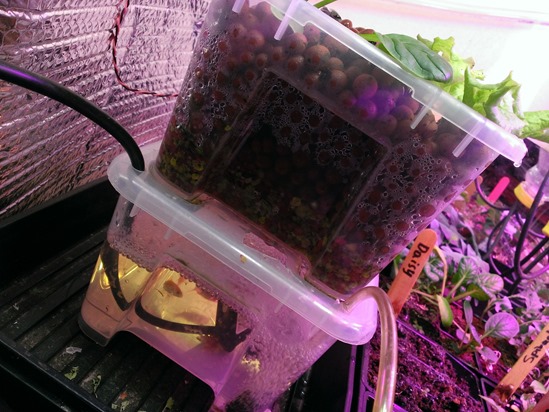
I then filled the top tub 1/3 with aquarium gravel (washed pea gravel would work as well) that I had sitting the the garage and topped the rest with some clay pellets.
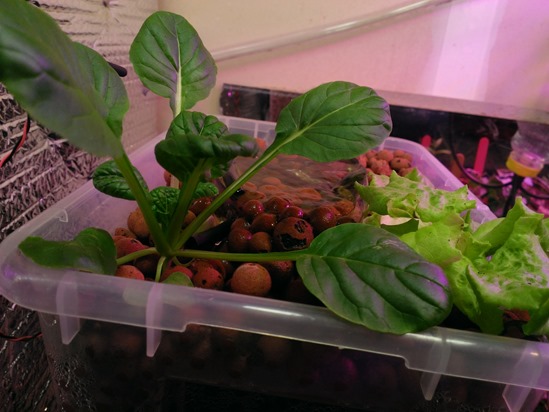
Next add some plants and pour water from the top until the tub below is full, start the pump and add a few goldfish and the process begins.
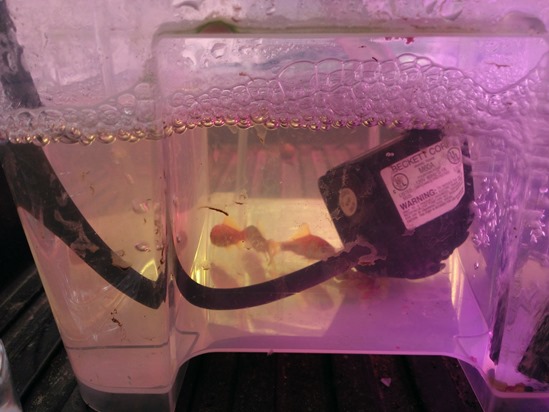
As the fish breath, poop, and pee they will produce ammonia (NH4) this is pretty worthless to the plants but after a few weeks Nitrosomas bacteria will begin converting the ammonia (NH4) to Nitrates (NO2) which plants can absorb some of the nitrogen from but not very efficiently. Finally Nitrospira bacteria will convert the Nitrates (NO2) to Nitrates (NO3) which is easily converted by the plants producing some nice vibrant greens with fish poop.

You can even do this whole process without even having fish by simply adding pure ammonia to you water which will create the same natural bacterial processes without having to remember to feed your fish and a small bottle of the stuff only costs a couple dollars on Amazon.
How to make the most of a small garden
10 years ago small garden 1 Comment
Today’s post was written by Ricky, who works for www.SwallowAquatics.co.uk. Ricky is a garden lover and enjoys nothing more than spending time in his own, diminutive but beautiful garden.
So the size of your yard leaves a little – okay, a lot – to be desired, but that doesn’t mean you should permanently hang up your secateurs. You’ll be surprised at what you can squeeze into your space with a little ingenuity. Check out our tips below, and let us know your ideas!
Wall to wall

Image credit: The Blue Girl
When floor space is limited, it’s time to get creative with other surfaces. One trend that is particularly popular in small gardens is the living wall, or wall garden idea. There are various ways to create an interesting, structured display such as in the image above, but climbers such as ivy, honeysuckle and roses will work just as well and create a more unruly feel.
Hanging baskets are another great option for your vertical garden – as long as you hang them appropriately to avoid injuries! Check out some more ideas on how to structure your walled garden here.
Color pop
Sticking with the vertical surfaces idea, it’s important to make the most of any patches of wall or fence that peek through in between your plants and pots. You could paint walls or fences in a bright color to add interest even on the drabbest of days, or even use the space as a canvas and create a mural. Check out these tips on how to paint your fence well.
Man in the mirror

Image credit: jimwolffman
Mirrors are a small room’s best friend – and that applies to your outdoor room, too. Just like they do indoors, mirrors will make your garden seem bigger than it is by creating the illusion of extra space. Make sure you treat or the frame of your mirror so that it is protected from the elements.
Twinkle, twinkle

Image credit: Wonderlane
Garden lights don’t have to be restricted to tacky Christmas novelties, and there’s no need for your garden to end up looking like Blackpool Illuminations. As well as offering a little extra security during the darker hours, a few lawn lights will allow you to enjoy your garden for much longer and, when placed cleverly, can make use of the space to show off the best aspects of your garden.
Whether you want something subtle, or a more grotto-like feel as in the photo above, go for solar options for a low cost, environmentally friendly option. Here are a few tips on how to go about installing solar lighting in your yard.
Giving the Toads a Happy Home with Earth, Water and… Garden Furniture?
10.1 years ago guest post, pests, toads 2 Comments

There was a toad that lived in my mother’s garden, and I always considered myself lucky to happen to catch a glimpse of him by a rock before he hopped back into the dense flowers and vegetables. When the summer rain was fresh on the plants, little toad would always be hanging out by the edge of the garden. I always wondered what his home looked like, and why he lived in the garden instead of the wilderness. Now that I have my own garden, I wanted to see more of little toad and other amphibians. They truly are amazing animals, and it is such an honor to be able to provide a good habitat for them so I can sometimes look in on their life and wonder what it’s like to be a toad!
After a bit of research into what type of real estate really does it for amphibians, I found out I need to provide shelter, hibernation spots, and a breeding area. Implementing a few structures with earth, water and garden furniture will really give amphibians a nice place to settle down in. Here are some tips for making your own garden toad-friendly, whether it’s because you like the amphibians or just their positive effects on gardens.
Rocks
Toads love to hide under rocks, so scatter a few throughout the garden in piles and border any paths or boundaries. You can also use wooden logs for this. Either way, it adds some more design to your garden and comfort for the toads. Some toads will also hibernate underground, digging deep below the freezing line, but others will rely on cracks in wood or rocks because they aren’t as good at digging.
Interestingly enough, Scientific American maintains that many frogs will freeze to the point where their heart and lungs stop beating in the winter. The level of glucose in their vital organs acts as antifreeze and the heart and lungs will start working again once the temperature warms back up.
Ponds for mating, hydration, and hibernation
Even if you don’t have a pond, you may still get a happy toad to live in your garden as they are a dry-land equipped amphibian. If you want more variety such as frogs or salamanders though, install a pond to prove the adequate hydration and ecosystem they require.
Putting a small pond in or near your garden isn’t as hard as it sounds. I just dug a hole in the ground, covered it in strong plastic, and waited for the rain to fill it up. You can also fill it with water from the hose, but you will want to make sure the chlorine has fully evaporated by the time any amphibians come near it. If you pick an area of low ground where pools form naturally, the rain should be fine to fill it up.
A pond also provides a hibernation spot for aquatic frogs. They will partially bury themselves in the mud below the surface and take in oxygen from the water.
Make sure the pond is far enough away from chemically treated lawns, poisonous trees or other plants that pose a threat to amphibians and reptiles. Instead, proactively install plants that will proved shelter and attract the kind of insects amphibians enjoy.
Garden furniture for hiding
I really like the wild, overgrown look of vines twisting into everyday objects, so I decided to incorporate furniture into my garden to provide shade, depth of space, and a dense hiding spot for the amphibian residents of the garden. I found a really cool, intricate looking wrought iron bench and planted Black-eyed Susan vine transplants, weaving them through and around the bench. I like to think that the frogs, toads and salamanders love the natural looking fixture as a potential hiding spot.
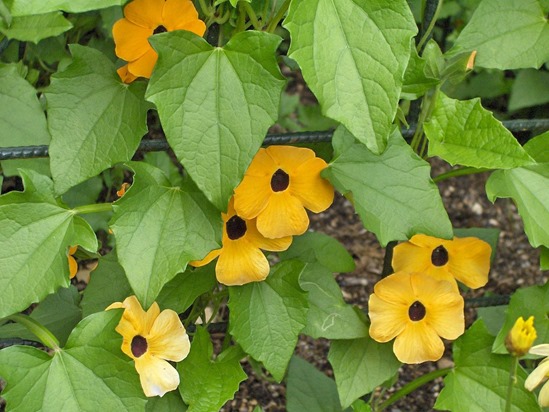
I also added another bench to the front-most outer side of my garden, this time using a cute little wicker design with cushions for actual sitting. Depending on the season, I leave this piece of furniture protected with a garden bench cover for the most part, and wait for it to rain in the early evenings. Once the rain ceases I go out to the garden and quietly uncover the bench for some amphibian (and rainbow) viewing relaxation. It’s probably one of the best things ever!
Amphibians are magnificent creatures, but they’re not the only garden-beneficial animals. What is your favorite garden wildlife, and how do you attract them to your yard?
New logo for CheapVegetableGardener.com
10.2 years ago Uncategorized 2 Comments
![CVGLogo2[1] CVGLogo2[1]](http://www.cheapvegetablegardener.com/wp-content/uploads/2014/02/CVGLogo21.jpg)
When I first created this blog 6 years ago I through together a simple logo with my very limited graphic design ability (or lack there of). I had always intended on improving this in the future but had never gotten the opportunity to do this.
Fortunately our Danish friends at AxisCepromup were great enough to put a logo together to replace our existing one. What do you think?


